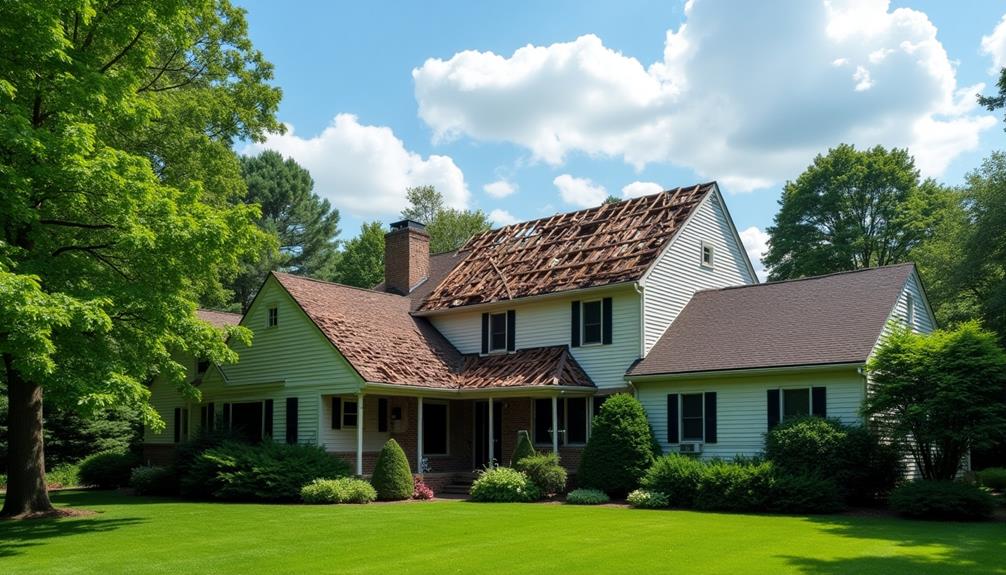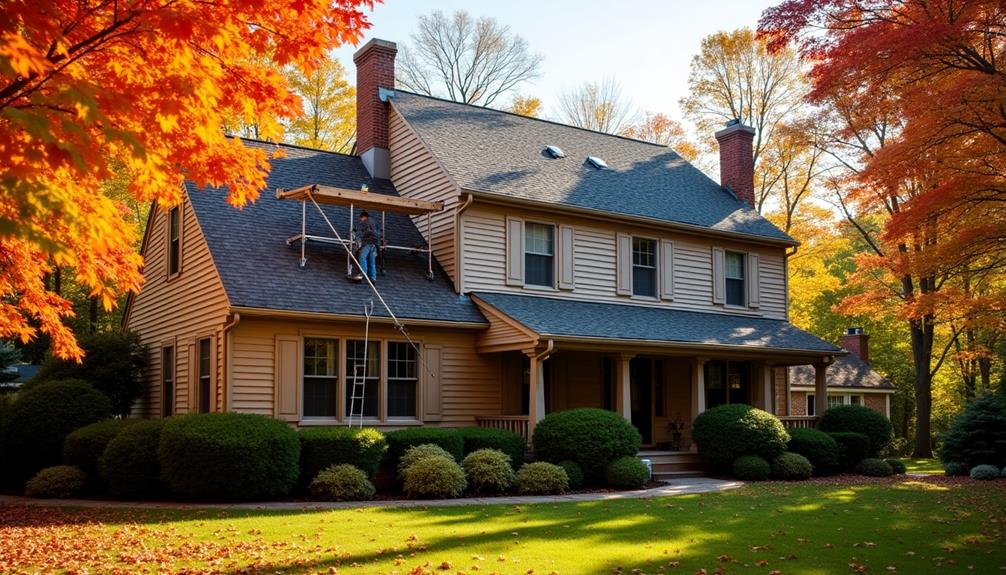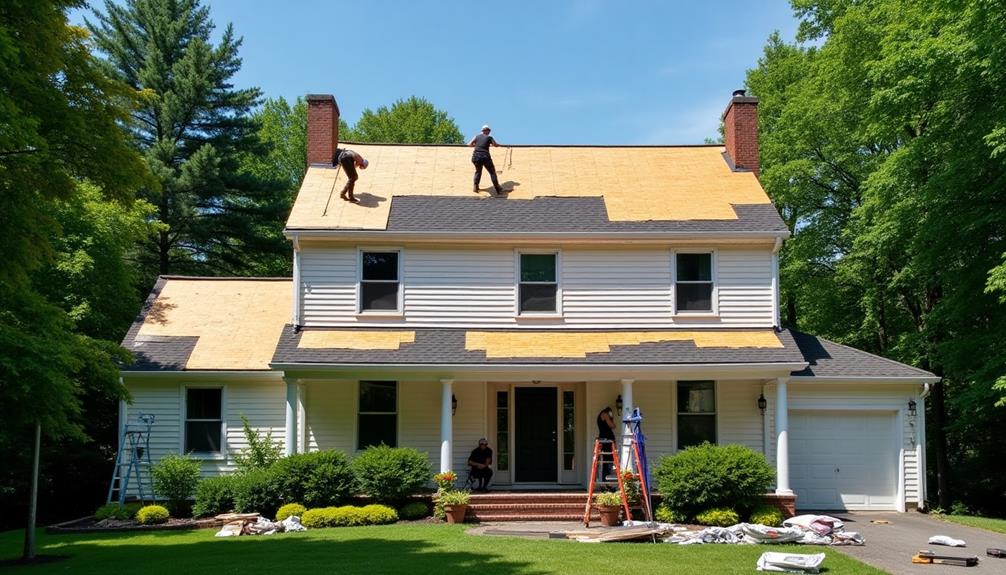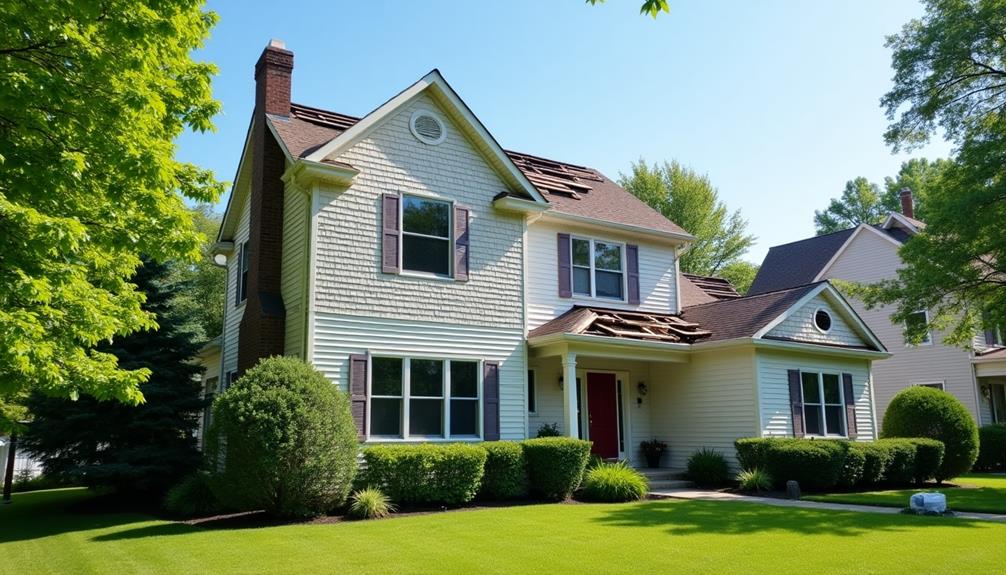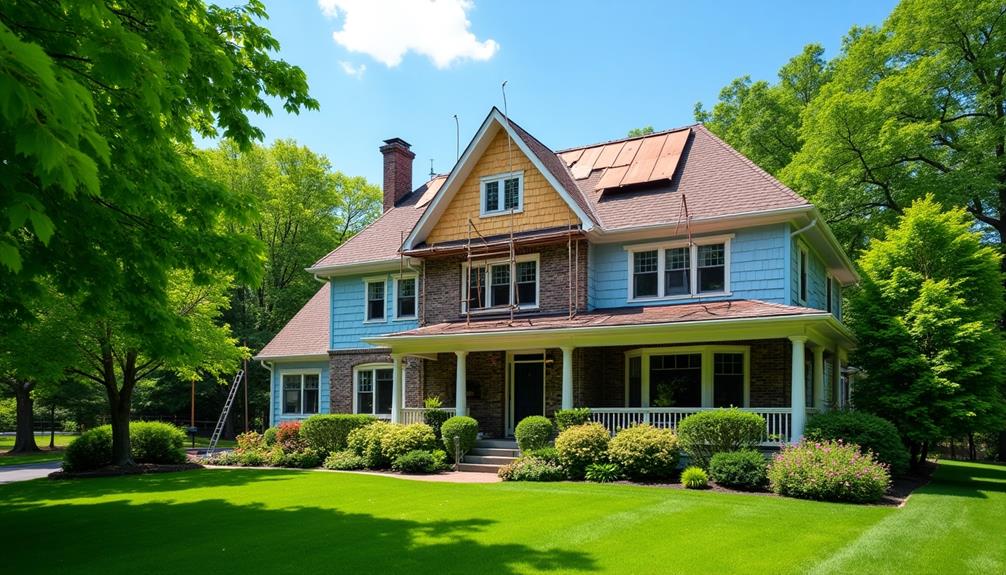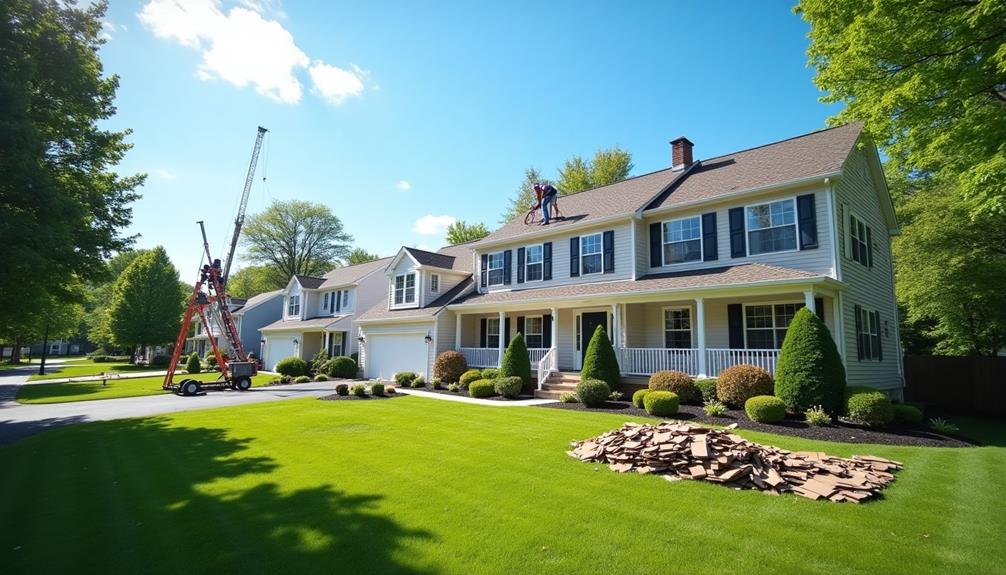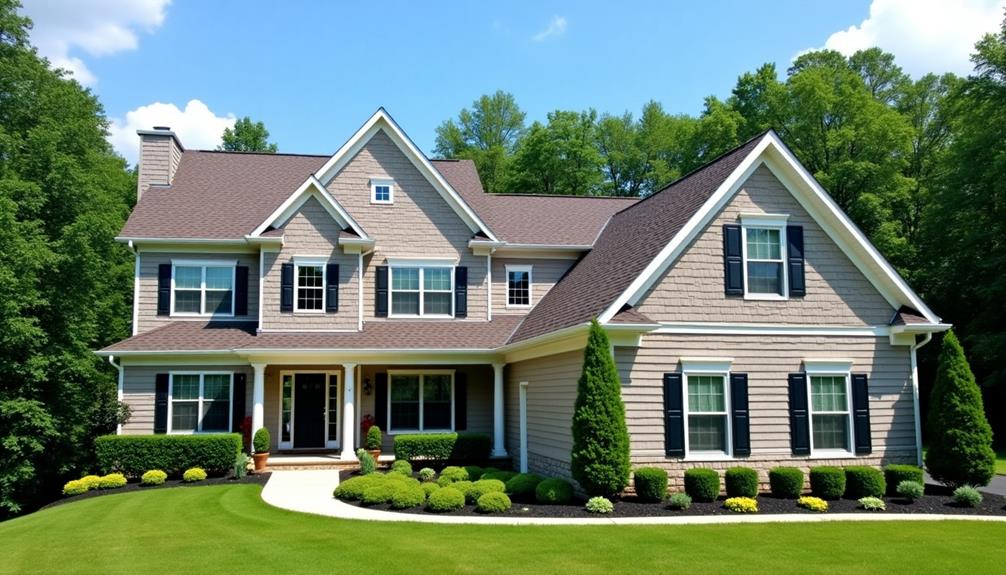If you're considering roof replacement in Moorestown, NJ, you should look for signs like leaking ceilings, damaged shingles, or sagging areas. Choosing the right materials—like asphalt shingles or metal roofing—can improve durability and energy efficiency. It's crucial to understand local permit requirements and safety protocols during the installation process. Be aware of costs related to labor, materials, and disposal fees, which can vary significantly. Preparing your home for replacement ensures a smooth job, and maintaining your new roof can extend its lifespan. Explore various options to enhance your home's curb appeal and protect your investment effectively.
Signs You Need a Roof Replacement
Your roof's integrity is crucial for protecting your home, and recognizing the signs that indicate a replacement is necessary can save you significant time and money.
One of the first indicators of trouble is leaking ceilings, which often stem from compromised roofing. If you notice water stains on your interior ceilings, it's a clear sign that water is penetrating your roof.
Additionally, inspect for shingle damage; curling, missing, or cracked shingles can lead to further issues.
Granule loss is another warning sign; if you see granules collecting in your gutters, your shingles may be deteriorating.
A sagging roof can indicate structural problems, and you must address this immediately to prevent further damage.
Age factors also play a crucial role; roofs older than 20 years may need replacement regardless of their current condition.
Don't overlook mold growth, as it can compromise your home's air quality.
Ventilation issues can exacerbate energy inefficiency, leading to higher utility bills.
Lastly, if you suspect a pest infestation, it's vital to evaluate your roof's condition, as pests can cause significant structural damage.
Recognizing these signs early can help maintain your home's safety and value.
Understanding Roofing Materials
Choosing the right roofing material is essential for ensuring durability and performance. You'll find various options on the market, each offering unique benefits.
Asphalt shingles are popular due to their cost-effectiveness and ease of installation, but advancements in roofing innovations have introduced materials like metal and synthetic tiles that boast superior longevity and resilience.
Metal roofing, for instance, is known for its exceptional material durability, often lasting over 50 years with minimal maintenance. It's resistant to extreme weather conditions, making it an excellent choice for areas prone to storms.
On the other hand, synthetic tiles mimic the appearance of traditional materials while providing enhanced durability and energy efficiency.
Another innovative option is thermoplastic polyolefin (TPO) roofing, which is gaining traction in commercial applications. This single-ply membrane offers excellent UV resistance and reflects heat, contributing to lower energy costs.
Benefits of Local Roofing Contractors
Opting for local roofing contractors can significantly enhance the roof replacement process in Moorestown, NJ. When you choose professionals from your area, you gain access to invaluable local expertise that's tailored to the specific environmental conditions and building codes of the region. This ensures that your new roof is not only durable but also compliant with local regulations.
Additionally, working with local contractors fosters community support. By investing in your neighborhood, you contribute to the local economy and strengthen relationships within the community.
Here's a quick comparison to illustrate the benefits:
| Benefit | Local Contractors | Non-Local Contractors |
|---|---|---|
| Local Expertise | Knowledge of local codes | General knowledge |
| Quick Response Time | Faster service | Potential delays |
| Community Support | Builds local economy | Limited community ties |
The Roof Replacement Process
When you begin the roof replacement process, an initial inspection is crucial to assess the condition of your existing roof and identify any underlying issues.
Following this, the installation phase involves precise measurements and careful placement of materials to ensure durability and compliance with local codes.
Initial Inspection Steps
Before you commit to a roof replacement, conducting a thorough initial inspection is essential to identify any underlying issues and determine the best course of action.
Start by using a comprehensive roof inspection checklist to ensure you cover all critical areas. Look for common inspection issues such as missing or damaged shingles, which can lead to leaks and further deterioration.
Next, examine the flashing around chimneys, vents, and skylights for signs of rust or improper sealing.
Pay attention to the gutters and downspouts, ensuring they're clear of debris and functioning correctly, as poor drainage can cause water damage.
Check for sagging areas in the roof, which may indicate structural weaknesses.
Inspect the attic for signs of moisture, mold, or water stains, as these can signal roof leaks.
Installation and Cleanup
During the roof replacement process, efficient installation and thorough cleanup are crucial for a successful outcome.
You'll begin with roof safety by ensuring that all personnel are equipped with proper safety gear, including harnesses and helmets. Implementing fall protection measures helps minimize risks during the installation.
Once the old roof is removed, your crew will start laying down the new materials. Precision is vital; each shingle or tile must be correctly aligned for optimal performance.
Pay attention to ventilation and underlayment installation, as these elements contribute significantly to the roof's durability and energy efficiency.
As the installation progresses, make sure to establish a system for debris disposal. Keeping the job site clean not only promotes safety but also enhances efficiency.
You should have designated bins for shingles, nails, and other waste materials. Regularly clearing debris reduces tripping hazards and allows for a more organized workspace.
Cost Factors to Consider
Several key cost factors influence the overall price of roof replacement in Moorestown, NJ.
First, labor costs can vary significantly based on the contractor's experience and the complexity of the project. More experienced contractors might charge higher rates, but they often deliver better quality work.
Material prices also play a crucial role; different roofing materials, from asphalt shingles to metal, come with varying costs.
Design choices you make can affect both material and labor costs. Intricate designs may require more skilled labor and specialized materials.
Weather conditions during installation can impact costs as well; inclement weather might necessitate delays, increasing labor expenses.
Additionally, disposal fees for your old roofing materials should be factored in, as these can add to the overall budget.
You'll also want to consider insurance coverage, as some policies may cover part of the replacement costs.
Financing options can help manage upfront expenses, while warranty terms can influence long-term costs related to repairs or replacements.
Lastly, energy efficiency should be evaluated, as certain roofing materials can reduce energy bills over time, providing long-term savings.
Choosing the Right Roofing Style
When selecting a roofing style, you need to consider architectural compatibility with your home's design, as well as the local climate's impact on material performance.
Balancing your budget with aesthetic preferences is also crucial to ensure you achieve both functionality and visual appeal.
Architectural Compatibility Considerations
Choosing the right roofing style is crucial for ensuring architectural compatibility with your home's existing design. When selecting a new roof, you should consider various roof styles that complement your house's overall aesthetic. For instance, if your home features a Colonial design, opting for a gable roof may enhance design harmony, while a modern flat roof could disrupt the visual flow.
It's essential to analyze your neighborhood's architectural trends. Maintaining consistency with local styles not only contributes to your home's curb appeal but also protects its market value. Pay attention to roof pitch, materials, and colors that match or accentuate your home's facade.
Consider using materials that reflect the period of your home; for example, slate or cedar shakes can evoke a traditional feel, while metal roofing can lend a contemporary look.
Additionally, think about how your new roofing choice interacts with other architectural elements like chimneys, dormers, and siding. By ensuring that your new roof aligns with the established design language, you'll create a cohesive appearance that enhances both beauty and functionality.
Climate Impact Evaluation
In evaluating climate impact, selecting the right roofing style is vital for optimizing energy efficiency and durability. Your choice of roofing materials directly affects your home's climate resilience, helping it withstand extreme weather conditions and temperature fluctuations.
For instance, reflective roofing materials can significantly reduce heat absorption, lowering cooling costs during hot summers in Moorestown, NJ.
Consider materials that promote environmental sustainability, such as metal or shingles made from recycled content. These options not only minimize waste but also provide excellent insulation, contributing to energy savings.
Additionally, choose roofing styles that facilitate water drainage, reducing the risk of leaks and water damage during heavy rains.
Ventilation is another critical aspect; a well-ventilated roof can prevent heat buildup in the attic, aiding in temperature regulation and prolonging your roofing system's lifespan.
By prioritizing these factors, you'll not only enhance your home's performance but also align with eco-friendly practices.
Ultimately, the right roofing style will play a significant role in ensuring that your home remains energy-efficient, durable, and resilient against the climate challenges that Moorestown may present.
Budget and Aesthetics Balance
Balancing budget considerations with aesthetic preferences is key to selecting the right roofing style for your home. You'll want to assess various cost-effective options that align with both your financial constraints and your desired look.
Asphalt shingles, for instance, are a popular choice due to their affordability and versatility, allowing for a variety of styles that can complement different architectural designs.
As you explore roofing materials, keep an eye on current design trends. Metal roofing, for example, has gained traction not only for its durability but also for its sleek, modern appearance.
It's essential to consider the long-term investment as well; while some materials may have a higher upfront cost, their longevity and energy efficiency could save you money in the long run.
Don't overlook the importance of color and texture in your roofing choice. A well-chosen roof can significantly enhance your home's curb appeal, adding value to your property.
Permits and Regulations in Moorestown
Understanding the permits and regulations for roof replacement in Moorestown is crucial for homeowners. Before you initiate any roofing project, familiarize yourself with the local zoning laws and permit requirements.
Moorestown's municipal guidelines dictate specific construction codes that your project must adhere to, ensuring safety and compliance.
You'll need to submit a detailed application, which includes information about the materials and methods you'll use. The application timeline can vary, so it's wise to plan ahead.
Once your application is submitted, you'll undergo an inspection process where the local authorities will verify that your project meets all necessary codes and standards.
As a homeowner, it's your responsibility to ensure that all work complies with the regulations set forth by the municipality. This includes obtaining the necessary permits and scheduling compliance checks during the roofing process.
Failing to adhere to these guidelines can result in fines or even the need to redo work that doesn't meet standards. By understanding these requirements, you can avoid potential setbacks and ensure a smooth roof replacement experience in Moorestown.
Preparing Your Home for Replacement
Before your roof replacement begins, you need to clear all exterior areas around your home to ensure a safe working environment.
It's also essential to secure any indoor belongings that could be affected by noise or debris.
Lastly, maintain open communication with your contractors to address any concerns promptly and facilitate a smooth process.
Clear Exterior Areas
Preparing your home for a roof replacement involves clearing the exterior areas to ensure a smooth and efficient process. This preparation is crucial for minimizing the risk of damage to your property and ensuring safety for the roofing crew. Start by removing outdoor furniture and any other items that could obstruct the work area.
Here's a simple checklist to guide you:
| Action | Description |
|---|---|
| Remove Outdoor Furniture | Take away chairs, tables, and any decor items. |
| Clear Roof Perimeter | Trim trees or shrubs that overhang the roof. |
| Secure Loose Items | Store garden tools, planters, and decorations. |
| Inspect for Roof Debris | Check for loose shingles or debris on the roof. |
Secure Indoor Belongings
When it comes to a roof replacement, securing indoor belongings is just as important as clearing outdoor spaces. The noise and vibrations from the construction can inadvertently cause damage to your valuable items, so taking the necessary precautions is crucial.
Start by identifying all valuable items within your home, such as electronics, artwork, and heirlooms. Move these items to a safe location, ideally a room that's furthest from the construction area. If that's not feasible, consider covering them with tarps or blankets for indoor protection. This will help shield them from dust, debris, and potential impacts.
Additionally, take down any wall hangings or decorations that might be at risk during the replacement process. Even small items on shelves can be disturbed by vibrations, so it's wise to secure or relocate them.
Don't forget to inform family members, especially children and pets, about the construction schedule to keep them away from busy areas.
Communicate With Contractors
Securing your indoor belongings sets the stage for effective communication with your contractors. Clear dialogue ensures everyone understands contractor expectations, which minimizes misunderstandings and streamlines the roof replacement process. Start by discussing your project goals, timelines, and budget. Make sure you're both on the same page about materials, styles, and any additional features.
Consider this table to help you prepare for your conversations:
| Topic | Your Notes | Contractor's Response |
|---|---|---|
| Project Timeline | Desired start and finish dates | Estimated schedule |
| Material Preferences | Specific brands or types | Recommended options |
| Budget | Maximum spend | Detailed cost breakdown |
| Questions | Any concerns or clarifications | Responses and solutions |
Utilizing this table can help you stay organized and ensure effective communication during your discussions. Be proactive in addressing any questions or concerns, as this fosters a collaborative environment. Always remember, open lines of communication will not only enhance the efficiency of your roof replacement but also build trust with your contractors, leading to a smoother project experience.
Maintenance Tips for New Roofs
Maintaining your new roof is crucial to ensuring its longevity and performance. Regular roof inspections are essential; schedule them at least twice a year, ideally in spring and fall. During these inspections, look for signs of damage such as missing shingles, cracks, or debris accumulation. Addressing issues early can prevent costly repairs down the line.
Seasonal maintenance is equally important. In winter, remove snow buildup to prevent ice dams, which can lead to water infiltration. In autumn, clearing leaves and debris from gutters and downspouts will ensure proper drainage and reduce the risk of water damage to your roof.
Watch for overhanging branches that may scrape against your roof or drop leaves and debris. Trimming these branches can minimize wear on your roofing materials. Additionally, check for signs of algae or moss growth, which can deteriorate shingles. If you notice any, a gentle cleaning solution can help remove them without damaging the surface.
Lastly, maintain proper attic ventilation. This helps regulate temperature and moisture levels, reducing the risk of condensation and extending the life of your roof.
Enhancing Curb Appeal With a New Roof
A well-maintained roof not only protects your home but also significantly enhances its curb appeal. When considering a roof replacement in Moorestown, NJ, you should focus on both color selection and roof styles to create an eye-catching exterior.
Selecting the right color is crucial; it can either complement or clash with your home's facade. Opt for shades that harmonize with your siding, trim, and landscaping. Neutral colors like grays and browns offer timeless appeal, while bold hues can make a striking statement.
In addition to color, the style of your new roof plays a vital role in your home's overall aesthetics. Whether you prefer the classic look of asphalt shingles, the elegance of slate, or the modern flair of metal roofing, each option presents unique characteristics that can elevate your home's appearance.
Furthermore, consider architectural elements that might enhance the roof's impact, such as dormers or decorative shingles.

